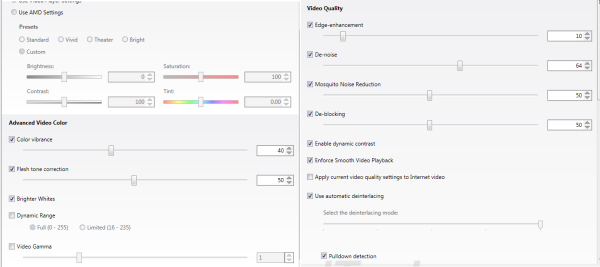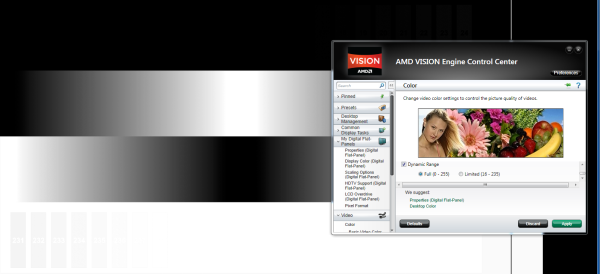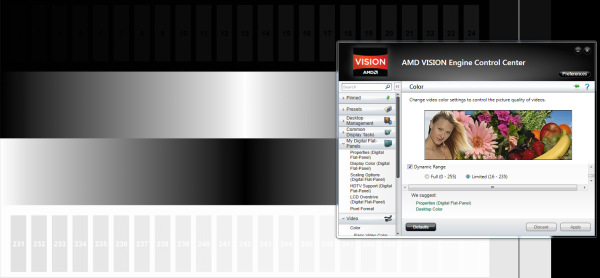AMD's Trinity : An HTPC Perspective
by Ganesh T S on September 27, 2012 11:00 AM ESTHTPC enthusiasts are often concerned about the quality of pictures output by the system. While this is a very subjective metric, we have been taking as much of an objective approach as possible. We have been using the HQV 2.0 benchmark in our HTPC reviews to identify the GPUs' video post processing capabilities. The HQV benchmarking procedure has been heavily promoted by AMD, but Intel also seems to be putting its weight behind that now.
The control panel for the Trinity GPU retains the host of options from earlier Catalyst releases. We used Catalyst 12.8 in our testing.
HQV scores need to be taken with a grain of salt. In particular, one must check the tests where the GPU lost out points. In case those tests don't reflect the reader's usage scenario, the handicap can probably be ignored. So, it is essential that the scores for each test be compared, rather than just the total value.
The HQV 2.0 test suite consists of 39 different streams divided into 4 different classes. For the Trinity HTPC, we used Cyberlink PowerDVD 12 with TrueTheater disabled and hardware acceleration enabled for playing back the HQV streams. The playback device was assigned scores for each, depending on how well it played the stream. Each test was repeated multiple times to ensure that the correct score was assigned. The scoring details are available in the testing guide from HQV.
Blu-rays are usually mastered very carefully. Any video post processing (other than deinterlacing) which needs to be done is handled before burning it in. In this context, we don't think it is a great idea to run the HQV benchmark videos off the disc. Instead, we play the streams after copying them over to the hard disk. How does the score compare to what was obtained by the Llano and Ivy Bridge at launch?
In the table below, we indicate the maximum score possible for each test, and how much each GPU was able to get. The HD4000 is from the Core i7-3770K with the Intel 8.15.10.2696 drivers. The AMD 6550D was tested with Catalyst 11.6 (driver version 8.862 RC1).
| HQV 2.0 Benchmark | ||||||
| Test Class | Chapter | Tests | Max. Score | AMD 6550D (Local file) | Intel HD4000 | AMD 7660D |
| Video Conversion | Video Resolution | Dial | 5 | 4 | 5 | 5 |
| Dial with Static Pattern | 5 | 5 | 5 | 5 | ||
| Gray Bars | 5 | 5 | 5 | 5 | ||
| Violin | 5 | 5 | 5 | 5 | ||
| Film Resolution | Stadium 2:2 | 5 | 5 | 5 | 5 | |
| Stadium 3:2 | 5 | 5 | 5 | 5 | ||
| Overlay On Film | Horizontal Text Scroll | 5 | 5 | 3 | 5 | |
| Vertical Text Scroll | 5 | 5 | 5 | 5 | ||
| Cadence Response Time | Transition to 3:2 Lock | 5 | 5 | 5 | 5 | |
| Transition to 2:2 Lock | 5 | 5 | 5 | 5 | ||
| Multi-Cadence | 2:2:2:4 24 FPS DVCam Video | 5 | 5 | 5 | 5 | |
| 2:3:3:2 24 FPS DVCam Video | 5 | 5 | 5 | 5 | ||
| 3:2:3:2:2 24 FPS Vari-Speed | 5 | 5 | 5 | 5 | ||
| 5:5 12 FPS Animation | 5 | 5 | 5 | 5 | ||
| 6:4 12 FPS Animation | 5 | 5 | 5 | 5 | ||
| 8:7 8 FPS Animation | 5 | 5 | 5 | 5 | ||
| Color Upsampling Errors | Interlace Chroma Problem (ICP) | 5 | 2 | 5 | 5 | |
| Chroma Upsampling Error (CUE) | 5 | 2 | 5 | 5 | ||
| Noise and Artifact Reduction | Random Noise | SailBoat | 5 | 5 | 5 | 5 |
| Flower | 5 | 5 | 5 | 5 | ||
| Sunrise | 5 | 5 | 5 | 5 | ||
| Harbour Night | 5 | 5 | 5 | 5 | ||
| Compression Artifacts | Scrolling Text | 5 | 3 | 5 | 5 | |
| Roller Coaster | 5 | 3 | 5 | 5 | ||
| Ferris Wheel | 5 | 3 | 5 | 5 | ||
| Bridge Traffic | 5 | 3 | 5 | 5 | ||
| Upscaled Compression Artifacts | Text Pattern | 5 | 3 | 3 | 3 | |
| Roller Coaster | 5 | 3 | 3 | 3 | ||
| Ferris Wheel | 5 | 3 | 3 | 3 | ||
| Bridge Traffic | 5 | 3 | 3 | 3 | ||
| Image Scaling and Enhancements | Scaling and Filtering | Luminance Frequency Bands | 5 | 5 | 5 | 5 |
| Chrominance Frequency Bands | 5 | 5 | 5 | 5 | ||
| Vanishing Text | 5 | 5 | 5 | 5 | ||
| Resolution Enhancement | Brook, Mountain, Flower, Hair, Wood | 15 | 15 | 15 | 15 | |
| Video Conversion | Contrast Enhancement | Theme Park | 5 | 5 | 5 | 5 |
| Driftwood | 5 | 5 | 5 | 5 | ||
| Beach at Dusk | 5 | 5 | 5 | 5 | ||
| White and Black Cats | 5 | 5 | 5 | 5 | ||
| Skin Tone Correction | Skin Tones | 10 | 7 | 7 | 7 | |
| Total Score | 210 | 184 | 197 | 199 | ||
We did some quick tests to ensure that all the post processing steps available for Blu-rays were also available for local files using MPC-HC's EVR renderer. AMD deserves kudos for being the only GPU vendor to get the local cadence detection (with respect to the shredding of overlay text) correct. In addition, they are the only ones to offer mosquito noise reduction as an option in addition the usual denoising setting. The chroma upsampling issue we noticed with the Llano is no longer an issue. With a score of 199, the 7660D with the Catalyst 12.8 drivers becomes the best performer on the HQV front. It is possible that the 7750's scores have also improved with these drivers, but we will take a look at that in another piece.
However, this doesn't mean that AMD's drivers are perfect. By default, the EVR / EVR-CP renderers rely on the drivers to supply the correct video levels to the display. As the screenshots below indicate, the meanings of full and limited seem to be interchanged.
Dynamic Range Set to Full for Video Playback (background)
Dynamic Range Set to Limited for Video Playback (background)
Setting the dynamic range to Limited (16-235) exposes black levels in the range 0-15 and 236-255, while setting it to Full (0-255) actually clips the color levels in the video in the background. This was one of the more obvious bugs that we encountered in our review process.













49 Comments
View All Comments
Denithor - Tuesday, October 2, 2012 - link
Which explains 1600p on 30" monitors, right?Granted, most of us don't sit 3-4' from our TV but I know even on my 50" 1080p barely cuts it (text is hard to read sometimes, fuzzy if I zoom in enough to read easily).
OCedHrt - Thursday, September 27, 2012 - link
Meaning, setting it to 16-235 means to discard 0-15 and 236-255 and expand the remainder to full RGB.Obviously I don't have a Trinity setup so I'm just speculating, but on my HD6400 there is a different parameter on the display configuration section to tweak screen output range - which I set to RGB full range.
ganeshts - Thursday, September 27, 2012 - link
I think you are referring to the pixel format output which is YCbCr 4:4:4 / YCbCr 4:2:2 / RGB Limited / RGB FullThe dynamic range aspect is orthogonal to the pixel format output over HDMI.
The screenshot posted is that of a video playing in the background. Sorry if that wasn't clear. I am not sure about AMD's terminology here, but any user setting the dynamic range to 16-235 would expect NOT to see values 0 - 15 and 236 - 255.
OCedHrt - Friday, September 28, 2012 - link
Yes I was referring to pixel format output. I use RGB Full. I was under the impression that YCbCr cannot display the ranges 0-15 and 236-255 but I think I might be wrong on this one. It is YV12 / YUY2 colorspaces that lack these ranges.And what you're saying about dynamic range is exactly what I'm saying is happening. If you select 16-235, 0-15 and 236-255 from the video is filtered out and the remaining is expanded back to 0-255. Thus a video decoded to YV12 / YUY2 space played on a full range display would have a greyish black or white without selecing 16-235 range. Meaning, the wording on AMD's UI is correct, just the whole idea behind it is confusing.
superccs - Friday, September 28, 2012 - link
Have all of our expectations of their new hardware dropped considerably? I am an AMD fan as much as the rest of you, but it just seems like we are trying so hard to find their stuff useful.CeriseCogburn - Saturday, October 13, 2012 - link
Good deal, another fanboy zombied out for years by the marketing hatred and hype useful idiots collective has shown a glimmer of light, hope that the slave mind can break free from the dirty chains.The new test is this: Would you put up with this crap from any other company or vendor ?
Hardcore69 - Friday, September 28, 2012 - link
- HTPC box: No point. A G540 + GTX 650 if you really want MadVR and 23.976.- Office box: No point. A G540 is enough for a basic everyday system
- Gaming box: No point. A dedicated card is still the answer for 1080p High/Ultra gaming i.e. real PC gaming.
Well? APU's are rather pointless. All this accelerated media crap, HD 1000 can do that too.
Medallish - Friday, September 28, 2012 - link
- HTPC Box: that's passively cooled: An A10-5700 would work great in there and be a nice upgrade!- Office/Workstation Box: GPU acceleration can make a lot of difference, not to mention people have different needs.
- Gaming Box: For someone who wants to game but don't want to shell out the money needed to get 1080p Ultra graphics, or as I see it, a gaming starter kit.
Well? APU's have plenty of point if you're not an out of touch Intel fanatic. Also did you even read the review? There was encoding and decoding that the APU did really well.
btw. I have a passively cooled HTPC, and a Laptop I use for office work, both based on APU's(Currently Llano, the HTPC is getting a Trinity upgrade though.) and I wouldn't want them any other way.
ssj3gohan - Monday, October 1, 2012 - link
Passively cooling a 130W box? Really?I'd like to see AMD trying a bit harder to keep their power consumption down, because in the end the reason for me to choose an i5-3570K was that like AMD it offered 'enough' GPU power, but at a much lower max power. My computer runs at well under 10W idle and about 75W max (OCCT+Furmark), more like 45W in normal use. I wouldn't be able to get near that kind of power consumption with equally-featured Trinity parts (aside from the lower CPU performance, which isn't really a big deal tbh).
(by the way, my 5.9W core i5-computer: http://ssj3gohan.tweakblogs.net/blog/8217/fluffy2-...
Medallish - Friday, October 5, 2012 - link
Yup, I've been working on my own little HTPC project(Although not as cool as yours :D). The Streacom FC5-OD is surprisingly good at cooling down even a 100W APU, right now I'm using a 3870k, I'm planning on getting the A10-5700 asap, and the final touch I plan on adding is the 6670, connect it to the opposite cooling ribs, however right now I'm running into a PSU limit, that I plan on countering by getting a slightly better PSU(250W CarPC PSU instead of a 150W picoPSU)But yeah despite the slightly higher load, the fact is on idle, and most likely average, AMD have really brought down power consumption with Trinity. But I like your setup, and will probably borrow a few ideas from there.